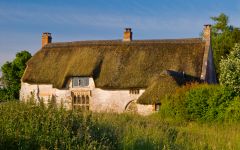UK Listed Buildings
Posted: 2009-06-11
If you are at all interested in history and travel in the UK you will undoubtedly have run across references to listed buildings. But what exactly IS a listed building? Who lists buildings, and why? Fear not, read on and all is will be revealed!
What is a listed building?
A listed building is one designated to be of historic importance, and, therefore, worth preserving. The listing of historic buildings started in 1950 as part of a growing awareness of the need to preserve the historic architecture of Britain in the face of post-war building and industrial growth.
What buildings can be listed?
Any building designated as historic can be listed, from a grand stately home to a menial thatched cottage, to a crumbling old barn.
Who lists buildings?
The body responsible for listing buildings in England is English Heritage, while in Scotland that task is handled by Heritage Scotland, in Wales by Cadw, and in Northern Ireland by the Ulster Architectural Heritage Society. Technically, these bodies do not directly list a building, they merely suggest buildings for listing to the Secretary of State for Culture, Media and Sport.
What are the Criteria for Listing a Building?
According to English Heritage, they suggest a building for listing when it is deemed to be of 'special architectural or historic interest'. Those are fairly broad terms of reference, and naturally, they are open to interpretation.
What grades of listed buildings are there?
In England and Wales, the grades used are I, II*, and II. In Scotland and Northern Ireland, the letter grades A, B, and C are used. Grade I and A are applied to buildings of exceptional interest. Grade II* and B are applied to 'particularly important buildings of more than special interest', while Grade II and C are used for buildings 'of special interest, warranting every effort to preserve them'. The most common designation is Grade II (or C).
What does it mean when a building is listed?
In practical terms, it means that the owners of the building have to abide by certain restrictions in remodelling, rebuilding, or otherwise altering the internal or external structure of the property. Such things as adding a new window or door, or enlarging an existing opening might be restricted.
In some cases, the materials used in any remodelling are restricted to the same sort of traditional materials used when the building was originally built. For example, you probably wouldn't be allowed to put a modern glass brick wall into a Grade I listed stately home. Special government grants may be available for urgent repairs to Grade I or II* buildings, which is a reflection of how nationally important these buildings are deemed to be.
Where can I find out more about listed buildings?
I thought you'd never ask! Here are some useful resources to learn more about listed buildings.
English Heritage
Historic Scotland
Ulster Architectural Heritage Society
Cadw
Listed Property Owners Club - for people who own listed buildings
Heritage.co.uk information page on listed buildings.
Heritage Gateway - online resource making some parts of the listed building data available to the public.
Department of Culture, Media and Sport, 2-4 Cockspur Street, London SWIY SDH
<< 10 Best Stone Circles in Britain - 10 Best Medieval Monasteries >>
Attraction search


